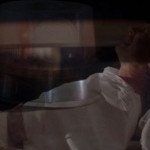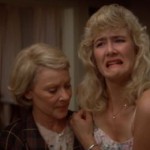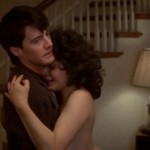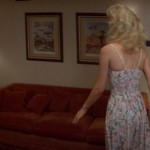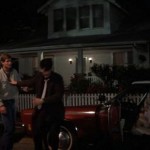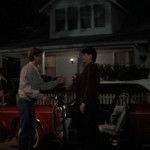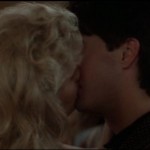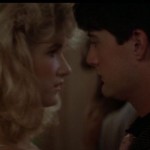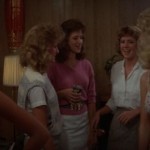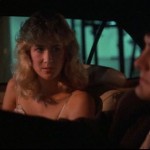Columns
-
The Blue Velvet Project, #134

Second #6298, 104:58 Another dissolve. 1. This one from a montage that’s as expressionistic and compressed as anything in any of Lynch’s films. Having been strapped into the gurney and loaded into the circa 1960s ambulance in all its hallucinatory, candy apple red, hearse-like terror, Dorothy struggles against her bindings, screaming, “Hold me! I’m falling! I’m falling.” The frame captures Dorothy’s dream-terror as it slowly dissolves into a shot of the ambulance siren, a moment that is both horrifying and deadpan, as the dull wail of the siren lends a sort of flat, matter-of-factness to sequence. 2. From Charles Musser, […]
-
The Blue Velvet Project, #133

Second #6251, 104:11 Sounds 1. “He put his disease in me.” (Dorothy to Sandy, around three seconds before this frame.) 2. Blue Velvet’s sound designer was the late Alan Splet, who had worked with Lynch beginning with his short film The Grandmother, in 1970. 3. In the distance, growing louder, the wail of an ambulance siren, which will arrive immediately after this shot for Dorothy. 4. The sound of Sandy crying, gradually drowned out by the wail of the siren. 5. What if the siren is, secretly, Sandy’s red thoughts at this moment, an outward auditory expression of her inner […]
-
The Blue Velvet Project, #132

Second #6204, 103:24 Fragments. Frames. Pieces of a puzzle: 1. “Sandy please. Sandy.” 2. Dorothy naked, but still wearing her wig. A performer. 3. Her performance before Sandy and Mrs. Williams. 4. The lamp in the corner. The trapped bird. 5. The flesh of Dorothy’s arm. 6. “Nothing can be achieved in the art of film until its form is understood to be the product of a completely unique complex: the exercise of an instrument which can function, simultaneously, both in terms of discovery and invention. . . . The camera provides the elements of the form, and, although it […]
-
The Blue Velvet Project, #131

Second #6157, 102:37 “Mom . . . is Dad home?” Sandy asks. If Blue Velvet were a comedy (and it approaches one at moments like this) there might be canned laughter following this line. After all, Sandy has just entered the house with the local nightclub singer, naked, bruised, and clinging to Sandy’s new boyfriend Jeffrey. Jeffrey in the realm of women: Dorothy (the bad one), Sandy (the good one), and Mrs. Williams (the dutiful wife and mother). What we’re looking at here is pure, raw, sex, unrestrained by custom, duty, or conventional notions of morality. Sandy knows it; it […]
-
The Blue Velvet Project, #130

Second #6110, 101:50 1. Jeffrey has his hands full. There is Mike (who, in one of Blue Velvet’s weird tonal shifts, has suddenly become apologetic and even Jeffrey’s ally), and there is Sandy helping the naked Dorothy into the backseat of Jeffrey’s car which will take them to Sandy’s house, where, stark naked in the living room, Dorothy will call Jeffrey “my secret lover” in front of Sandy and her mother, and where she will tell Sandy that Jeffrey “put his disease in me.” 2. The shot is so heavily coded with cinema’s past that it’s as if fragments of […]
-
The Blue Velvet Project, #129

Second #6063, 101:03 Layered with unfolding narrative information, this frame depicts the brief confrontation with Mike, who threatens to kick Jeffrey’s ass “right in front of your own stupid house.” With the vintage cars, Mike’s friends looking on, the fight over the girl, and the classical-era wide framing, this could be a scene straight of Rebel Without a Cause. Except that there, having just emerged in the background and unnoticed by everyone at this point, is the completely naked and bruised Dorothy, who appears on Jeffrey’s porch just behind Mike’s friends. In a few seconds Mike will be the first […]
-
The Blue Velvet Project, #’s 126, 127, 128

Second #5922, 98:42 Second # 5969, 99:29 Second # 6016, 100:16 In honor of Andrew Sarris, who passed away yesterday, three frames from Blue Velvet. Although Sarris’s essay “Notes on the Auteur Theory in 1962” (which appeared in the Winter 1962-63 issue of Film Culture) is best-known for its argument that “over a group of films, a director must exhibit certain recurring characteristics of style, which serve as his signature,” the essay also grapples with a more difficult, elusive, less discussed aspect of the auteur theory, what Sarris called a film’s “interior meaning”: The third and ultimate premise of the […]
-
The Blue Velvet Project, #125

Second #5875, 97:55 André Bazin once wrote, in “The Life and Death of Superimposition” (1946), that the fantastic in the cinema is possible only because of the irresistible realism of the photographic image. It is the image that can bring us face to face with the unreal, that can introduce the unreal into the world of the visible. By this point in Blue Velvet, with only around 20 minutes left in the film, we might feel justified in thinking that we have figured out the geographic parameters of its narrative world. The hardware store. The hospital room. Jeffrey’s car. Jeffrey’s […]
-
The Blue Velvet Project, #124

Second #5828, 97:08 At the basement party, Sandy has just assured her friends that it’s okay that she’s there with Jeffrey, not Mike. “It’s all taken care of,” she’ll tell Jeffrey in a few seconds, as “Mysteries of Love” is about to begin. They were asking a lot of money for the [“Song to the Siren” by This Mortal Coil] track, and we didn’t have any money. At one point Fred Caruso said, ‘David, you’re always writing little things. They could be called lyrics. Why don’t you write something and send it to Angelo and he will write you a […]
-
The Blue Velvet Project, #123

Second #5781, 96:21 Sandy and Jeffrey, on their way to the dance in the basement of a house. Jeffrey tends to arrive and depart the Williams house at night. The car creaks as it moves. What space does the car drive though? The space of streets at night, the insides of stores illuminated like enormous aquariums behind Sandy. But also the space of a mind, the mind of the film, with its own series of codes that reference other films, other images. Carl Jung: The collective unconscious—so far as we can say anything about it at all—appears to consist of […]
